
Kodak
USINFO | 2013-05-23 12:44
Eastman Kodak Company, commonly known as Kodak, is an American multinational imaging and photographic equipment, materials and services company headquartered in Rochester, New York, United States and incorporated in New Jersey. It was founded by George Eastman in 1888.
Kodak is best known for photographic film products. During most of the 20th century Kodak held a dominant position in photographic film, and in 1976 had a 90% market share of photographic film sales in the United States. The company's ubiquity was such that its tagline "Kodak moment" entered the common lexicon to describe a personal event that demanded to be recorded for posterity.
Kodak began to struggle financially in the late 1990s as a result of the decline in sales of photographic film and its slowness in transitioning to digital photography, despite having invented the core technology used in current digital cameras. 2007 was the most recent year in which the company made a profit. As part of a turnaround strategy, Kodak focused on digital photography and digital printing and attempted to generate revenues through aggressive patent litigation. In January 2012, Kodak filed for Chapter 11 bankruptcy protection. In February 2012, Kodak announced that it would cease making digital cameras, pocket video cameras and digital picture frames and focus on the corporate digital imaging market. In August 2012, Kodak announced the intention to sell its photographic film (excluding motion picture film), commercial scanners and kiosk operations as a measure to emerge from bankruptcy. In January 2013, a court approved financing for the company to emerge from bankruptcy by mid-2013. Kodak sold many of its patents for approximately $525,000,000 to a group of companies (including Apple, Google, Facebook, Amazon, Microsoft, Samsung, Adobe and HTC) under the name Intellectual Ventures and RPX Corporation.
| Eastman Kodak Company | |
 |
|
| Type | Public company |
| Traded as | OTCQB: EKDKQ |
| Industry |
Digital imaging Photography |
| Founded | 1888 (1888) |
| Founder(s) | George Eastman |
| Headquarters | Rochester, NY, US |
| Area served | Worldwide |
| Key people |
Antonio M. Perez (Chairman and CEO) Philip J. Faraci (President and COO) |
| Products | Digital imaging and photographic materials, equipment and services |
| Revenue | US$ 6.02 billion (2011) |
| Operating income | US$ −600 million (2011) |
| Net income | US$ −764 million (2011) |
| Total assets | US$ 4.67 billion (2011) |
| Total equity | US$ −2.35 billion (2011) |
| Employees | 13,094 (2012) |
| Website | www.kodak.com |
Name
The letter k was a favorite of Eastman's; he is quoted as saying, "it seems a strong, incisive sort of letter." He and his mother devised the name Kodak with an Anagrams set. Eastman said that there were three principal concepts he used in creating the name: it should be short, easy to pronounce, and not resemble any other name or be associated with anything else.
It has also been suggested that Kodak originated from the suggestion of David Houston, a fellow photographic inventor who held the patents to several roll film camera concepts that he later sold to Eastman. Houston, who started receiving patents in 1881, was said to have chosen Nodak as a nickname of his home state, North Dakota (NoDak). This is contested by other historians, however, who cite that Kodak was trademarked prior to Eastman's buying Houston's patents.
History
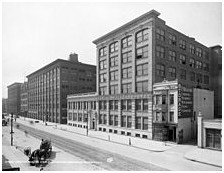
The Kodak factory and main office in Rochester, circa 1910
From the company's founding by George Eastman in 1889, Kodak followed the razor and blades strategy of selling inexpensive cameras and making large margins from consumables — film, chemicals and paper. As late as 1976, Kodak commanded 90% of film sales and 85% of camera sales in the U.S., according to a 2005 case study for Harvard Business School. This seemingly unassailable competitive position would foster an unimaginative and complacent corporate culture.
Rivalry with Fujifilm
Japanese competitor Fujifilm entered the U.S. market (via Fuji Photo Film U.S.A.) with lower-priced film and supplies, but Kodak did not believe that American consumers would ever desert its brand.[citation needed] Kodak passed on the opportunity to become the official film of the 1984 Los Angeles Olympics; Fuji won these sponsorship rights, which gave them a permanent foothold in the marketplace. Fuji opened a film plant in the U.S., and its aggressive marketing and price cutting began taking market share from Kodak. Fuji went from a 10% share in the early 1990s to 17% in 1997. Meanwhile, Kodak made little headway in Japan, the second-largest market for photo film and paper after the United States. Fuji also made headway into the professional market with specialty transparency films such as Velvia and Provia, which competed successfully with Kodak's signature professional product, Kodachrome, but used the more economical and common E-6 processing machines which were standard in most processing labs, rather than the dedicated machines required by Kodachrome. Fuji's films soon also found a competitive edge in higher-speed negative films, with a tighter grain structure.
In May 1995, Kodak filed a petition with the US Commerce Department under section 301 of the Commerce Act arguing that its poor performance in the Japanese market was a direct result of unfair practices adopted by Fuji. The complaint was lodged by the United States with the World Trade Organization. On January 30, 1998, the WTO announced a "sweeping rejection of Kodak's complaints" about the film market in Japan. Kodak's financial results for the year ending December 1997 showed that company's revenues dropped from $15.97 billion in 1996 to $14.36 billion in 1997, a fall of more than 10%; their net earnings went from $1.29 billion to just $5 million for the same period. Kodak's market share plunged from 80.1% to 74.7% in the United States, a one year drop of five percentage points that had observers suggesting that Kodak was slow to react to changes and underestimated its rivals.
Although from the 1970s both Fuji and Kodak recognized the upcoming threat of digital photography, and although both sought diversification as a mitigation strategy, Fuji was more successful at diversification.
Shift to digital
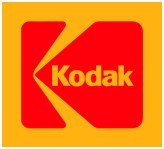
The Kodak logo from 1987 to 2006.
Although Kodak developed a digital camera in 1975, the first of its kind, the product was dropped for fear it would threaten Kodak's photographic film business. In the 1990s, Kodak planned a decade-long journey to move to digital technology. CEO George M. C. Fisher reached out to Microsoft and other new consumer merchandisers. Apple's pioneering QuickTake consumer digital cameras, introduced in 1994, had the Apple label but were produced by Kodak. The DC-20 and DC-25 launched in 1996. Overall, though, there was little implementation of the new digital strategy. Kodak's core business faced no pressure from competing technologies, and as Kodak executives could not fathom a world without traditional film there was little incentive to deviate from that course. Consumers gradually switched to the digital offering from companies such as Sony. In 2001 film sales dropped, which was attributed by Kodak to the financial shocks caused by the September 11 attacks. Executives hoped that Kodak might be able to slow the shift to digital through aggressive marketing.
Under Fisher's successor as CEO, Daniel Carp, Kodak made its move in the digital camera market, with its EasyShare family of digital cameras. Kodak spent tremendous resources studying customer behavior, finding out that women in particular loved taking digital photos but were frustrated in moving them to their computers. This key unmet consumer need became a major opportunity. Once Kodak got its product development machine started, it released a wide range of products which made it easy to share photos via PCs. One of their key innovations was a printer dock, where consumers could insert their cameras into this compact device, press a button, and watch their photos roll out. By 2005, Kodak ranked No. 1 in the U.S. in digital camera sales that surged 40% to $5.7 billion.
Despite high growth, Kodak failed to anticipate how fast these digital cameras became commodities, with low profit margins, as more companies entered the market in the mid-2000s. In 2001 Kodak held the No. 2 spot in U.S. digital camera sales (behind Sony) but it lost $60 USD on every camera sold, while there was also a dispute between employees from its digital and film divisions. The film business, where Kodak enjoyed high profit margins, fell 18% in 2005. The combination of these two factors resulted in disappointing profits overall. Its digital cameras soon became undercut by Asian competitors that could produce their offerings more cheaply. Kodak had a 27 percent market-leading share in 1999, that dwindled to 15 percent by 2003. In 2007 Kodak was No. 4 in U.S. digital camera sales with a 9.6 percent share, and by 2010 it held 7 percent in seventh place behind Canon, Sony, Nikon, and others, according to research firm IDC. Also an ever-smaller percentage of digital pictures were being taken on dedicated digital cameras, being gradually displaced in the late 2000s by cameras on cellphones, smartphones, and tablets.
Physicist Frank Duarte has argued that several major analog-era imaging companies (including Canon, Nikon, Leica, and Fuji) successfully transitioned from analog to digital, thus indicating that the switch to digital technology is not the only reason for Kodak's decline. A significant factor, in addition to managerial deficiencies, he argues, was the transformation (began in the early 1990s) from a widely diversified chemical manufacturer to a company mainly focused on imaging.
New strategy

Kodak headquarters in Rochester, New York, United States
Kodak then began a strategy shift. Previously Kodak had done everything in-house, but CEO Antonio Perez shut down film factories and eliminated 27,000 jobs as it outsourced its manufacturing.[33] Perez invested heavily in digital technologies and new services that capitalized on its technology innovation to boost profit margins. He also spent hundreds of millions of dollars to build up a high-margin printer ink business to replace shriveling film sales. Kodak's ink strategy rejects the razor and blades business model used by the dominant market leader Hewlett Packard in that Kodak's printers are expensive but the ink is cheaper. As of 2011, these new lines of inkjet printers are said to be on verge of turning a profit, although some analysts are skeptical as printouts have been replaced gradually by electronic copies on computers, tablets, and smartphones. Home photograph printers, high-speed commercial inkjet presses, workflow software, and packaging are viewed as the company's new core businesses, with sales from those four businesses projected to double to nearly $2 billion in revenue in 2013 and account for 25 percent of all sales.
Kodak has also turned to aggressive patent litigation in order to generate revenue. In 2010, it received $838 million from patent licensing that included a settlement with LG.
In 2011, despite the turnaround progress, Kodak rapidly used up its cash reserves, stoking fears of bankruptcy; it had $957 million in cash in June 2011, down from $1.6 billion in January 2001. In 2011, Kodak reportedly explored selling off or licensing its vast portfolio of patents in order to stave off bankruptcy. By January 2012, analysts suggested that the company could enter bankruptcy followed by an auction of its patents, as it was reported to be in talks with Citigroup to provide debtor-in-possession financing. This was confirmed on January 19, 2012, when the company filed for Chapter 11 bankruptcy protection and obtained a $950 million, 18-month credit facility from Citigroup to enable it to continue operations. Under the terms of its bankruptcy protection, Kodak had a deadline of February 15, 2013 to produce a reorganization plan.
In April 2013, Kodak showed its first Micro Four Thirds camera, to be manufactured by JK Imaging.
Timeline
1880 to 1900
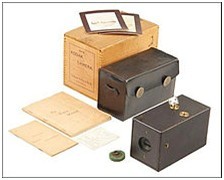
An original Kodak camera, complete with box, camera, case, felt lens plug, manual, memorandum and viewfinder card
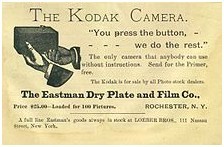
An advertisement from The Photographic Herald and Amateur Sportsman (November 1889).
• April 1880: George Eastman leased the third floor of a building on State Street in Rochester and began the commercial manufacture of dry plates.
• January 1, 1881: Eastman and businessman Henry A. Strong formed a partnership called the Eastman Dry Plate Company.[40] Eastman resigned his position at the Rochester Savings Bank in order to work full-time at the Eastman Dry Plate Company.
• 1884: The Eastman-Strong partnership was dissolved and the Eastman Dry Plate and Film Company formed with 14 shareowners. The Eastman Dry Plate Company was responsible for the first cameras suitable for non expert use.
• 1885: George Eastman invented roll film, the basis for the invention of motion picture film, as used by early filmmakers and Thomas Edison.
• September 4, 1888: Eastman registered the trademark Kodak.
• 1888: The first model of the Kodak camera appeared. It took round pictures 6.4 cm (2.5 inches) in diameter, was of the fixed focus type, and carried a roll of film enough for 100 exposures. Its invention practically marked the advent of amateur photography, as before that time both apparatus and processes were too burdensome to classify photography as recreation. The roll film used in the first model of the Kodak camera had a paper base but was soon superseded by a film with a cellulose base, a practical transparent flexible film. The first films had to be loaded into the camera and unloaded in the dark room, but the film cartridge system with its protecting strip of non-actinic paper made it possible to load and unload the camera in ordinary light. The Kodak Developing Machine (1900) and its simplified successor, the Kodak Film Tank, provided the means for daylight development of film, making the dark room unnecessary for any of the operations of amateur photography. The earlier types of the Kodak cameras were of the box form and of fixed focus, and as various sizes were added, devices for focusing the lenses were incorporated.
• 1889: The Eastman Company was formed.
• 1891: George Eastman began to produce a second line of cameras, the Ordinary range.
• 1892: It was renamed the Eastman Kodak Company in 1892. Eastman Kodak Company of New York was organized. He coined the advertising slogan, "You Press the Button, We Do the Rest." The Kodak company thereby attained its name from the first simple roll film cameras produced by Eastman Dry Plate Company, known as the "Kodak" in its product line.
• Early 1890s: The first folding Kodak cameras were introduced. These were equipped with folding bellows that permitted much greater compactness.
• 1895: The first pocket Kodak camera, the $5 Pocket Kodak, was introduced. It was of the box form type, slipping easily into an ordinary coat pocket, and producing negatives 1½ x 2 inches.
• 1897: The first folding pocket Kodak camera was introduced, and was mentioned in the novel Dracula.
• 1899: George Eastman purchased the patent for Velox photographic paper from Leo Baekeland for $1,000,000. After this time, Velox paper was then sold by Eastman Kodak.
1900 to 2000

A Brownie No 2. camera
• 1900: The Brownie camera was introduced, creating a new mass market for photography.
• 1901: The present company, Eastman Kodak Company of New Jersey, was formed under the laws of that state. Eventually, the business in Jamestown was moved in its entirety to Rochester, and the plants in Jamestown were demolished.
• By 1920: An “Autographic Feature” provided a means for recording data on the margin of the negative at the time of exposure. This feature was supplied on all Kodak cameras with the exception of a box camera designed for making panoramic pictures and was discontinued in 1932.
• 1920: Tennessee Eastman was founded as a wholly owned subsidiary. The company's primary purpose was the manufacture of chemicals, such as acetyls, needed for Kodak's film photography products.
• 1930: Eastman Kodak Company was added to the Dow Jones Industrial Average index on July 18, 1930. The company remained listed as one of the DJIA companies for the next 74 years, ending in 2004.
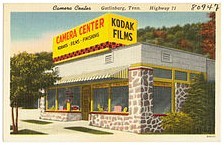
Kodak Camera Center, Tennessee, ca. 1930-1945
• 1932: George Eastman dies, taking his own life with a gun shot.
• 1935: Kodak introduced Kodachrome, a color reversal stock for movie and slide film.
• 1936: Kodak branches out into manufacture of hand-grenades.
• 1940-1944: Eastman Kodak ranked 62nd among United States corporations in the value of World War II military production contracts.
• 1949-1956: Kodak Introduces the Retina Series 35mm Camera
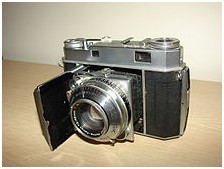
Kodak Retina Series Cameras were produced between 1949 until 1956. It also had the KodaChrome Technology
• 1959: Kodak introduced the Starmatic camera, the first automatic Brownie camera, which was sold in 10 million units over the next five years.
• 1963: Kodak introduced the Instamatic camera, an inexpensive, easy-to-load, point-and-shoot camera.
• 1975: Steven Sasson, then an electrical engineer at Kodak, invented the digital camera.
• 1976: The Bayer Pattern color filter array (CFA) was invented by Eastman Kodak researcher Bryce Bayer. The order in which dyes are placed on an image sensor photosite is still in use today. The basic technology is still the most commonly used of its kind to date. Also in 1976, Kodak introduced the first Kodamatic, instant picture cameras, using a similar film and technology to that of the Polaroid company.
o The company sold 90% of the photographic film in the US along with 85% of the cameras.
• 1981: Kodak was sued by Polaroid for infringement of its Instant Picture patents. The suit ran for five years, the court finally finding in favour of Polaroid in 1986.
• 1982: Kodak launched the Kodak Disc film format for consumer cameras. The format ultimately proved unpopular and was later discontinued.
• 1986: Kodak scientists created the world's first megapixel sensor, capable of recording 1.4 million pixels and producing a photo-quality 12.5 x 17.5 cm (5×7 inch) print.
• 1987: Dr. Ching W. Tang, a senior research associate, and his colleague, Steven Van Slyke, developed the first multi-layer OLEDs at the Kodak Research Laboratories, for which he later became a Fellow of the Society for Information Display (SID)
• 1993: Eastman Chemical, a Kodak subsidiary founded by George Eastman in 1920 to supply Kodak's chemical needs, was spun off as a separate corporation. Eastman Chemical became a Fortune 500 company in its own right.
• 1994: Apple Quicktake, the first ever digital camera was debuted by Apple Computer. It was manufactured by Kodak.
2000 to 2010
• 2003: Kodak introduced the Kodak EasyShare LS633 Digital Camera, the first camera to feature an AMOLED display, and the Kodak EasyShare Printer Dock 6000, the world's first printer-and-camera dock combination.
• November 2003: Kodak acquired the Israel-based company Algotec Systems, a developer of advanced picture archiving and communication systems (PACS), which enable radiology departments to digitally manage and store medical images and information.
• January 2004: Kodak announced that it would stop selling traditional film cameras in Europe and North America, and cut up to 15,000 jobs (around a fifth of its total workforce at the time).
• April 8, 2004: Kodak was delisted from the Dow Jones Industrial Average index, having been a constituent for 74 consecutive years.
• May 2004: Kodak signed an exclusive long-term agreement with Lexar Media, licencing the Kodak brand for use on digital memory cards designed, manufactured, sold, and distributed by Lexar.
• January 2005: The Kodak EasyShare-One Digital Camera, the world’s first Wi-Fi consumer digital camera capable of sending pictures by email, was unveiled at the 2005 CES.
• January 2005: Kodak acquired the Israel-based company OREX Computed Radiography, a provider of compact computed radiography systems that enable medical practitioners to acquire patient x-ray images digitally.
• January 2005: Kodak acquired the Burnaby, BC, Canada-based company Creo.
• January 2006: Kodak unveiled the Kodak EasyShare V570 Dual Lens Digital Camera, the world's first dual-lens digital still camera and smallest ultra-wide-angle optical zoom digital camera, at the CES. Using proprietary Kodak Retina Dual Lens technology, the V570 wrapped an ultra-wide angle lens (23 mm) and a second optical zoom lens (39 – 117 mm) into a body less than 2.5 cm (an inch) thick.
• April 2006: Kodak introduced the Kodak EasyShare V610 Dual Lens Digital Camera, at that time the world’s smallest 10× (38–380 mm) optical zoom camera at less than 2.5 cm (an inch) thick.
• August 1, 2006: Kodak agreed to divest its digital camera manufacturing operations to Flextronics, including assembly, production and testing.[59][60] As part of the sale it was agreed that Flextronics would manufacture and distribute consumer digital cameras for Kodak, and conduct some design and development functions for it. Kodak kept high-level digital camera design in house, continued to conduct research and development in digital still cameras, and retained all intellectual property and patents. Approximately 550 Kodak personnel transferred to Flextronics.
• January 10, 2007: Kodak agreed to sell Kodak Health Group to Onex Corporation for $2.35 billion in cash, and up to $200 million in additional future payments if Onex achieved specified returns on the acquisition. The sale was completed May 1. Kodak used part of the proceeds to fully repay its approximately $1.15 billion of secured term debt. Around 8,100 employees transferred to Onex, and Kodak Health Group was renamed Carestream Health. Kodak Health Group had revenue of $2.54 billion for the 12 months to September 30, 2006.
• April 19, 2007: Kodak announced an agreement to sell its light management films business, which produced films designed to improve the brightness and efficiency of liquid crystal displays, to Rohm and Haas. The divested business comprised 125 workers. As part of the transaction Rohm and Haas agreed to license technology and purchase equipment from Kodak, and lease Building 318 at Kodak Park. The sale price was not disclosed.
• May 25, 2007: Kodak announced a cross-licensing agreement with Chi Mei Optoelectronics and its affiliate Chi Mei EL (CMEL), enabling CMEL to use Kodak technology for active matrix OLED modules in a variety of small to medium size display applications.
• June 14, 2007: Kodak announced a two to fourfold increase in sensitivity to light (from one to two stops) compared to current sensor designs. This design was a departure from the classic "Bayer filter" by adding panchromatic or “clear” pixels to the RGB elements on the sensor array. Since these pixels are sensitive to all wavelengths of visible light, they collect a significantly higher proportion of the light striking the sensor. In combination with advanced Kodak software algorithms optimized for these new patterns, photographers benefited from an increase in photographic speed (improving performance in low light), faster shutter speeds (reducing motion blur for moving subjects), and smaller pixels (higher resolutions in a given optical format) while retaining performance. The technology was credited to Kodak scientists John Compton and John Hamilton.
• September 4, 2007: Kodak announced a five-year extension of its partnership with Lexar Media.
• November 2008: Kodak released the Kodak Theatre HD Player, allowing photos and videos stored on a computer to be displayed on an HDTV. Kodak licensed technology from Hillcrest Labs for the interface and pointer, which allowed a user to control the player with gestures.
• January 2009: Kodak posted a $137 million fourth-quarter loss and announced plans to cut up to 4,500 jobs.
• June 22, 2009: Kodak announced that it would cease selling Kodachrome color film by the end of 2009, ending 74 years of production, after a dramatic decline in sales.
• December 4, 2009: Kodak sold its organic light-emitting diode (OLED) business unit to LG Electronics, resulting in the lay-off of 60 people.
2010 to present
• December 2010: Standard & Poor's removed Kodak from its S&P 500 index.
• September 2011: Kodak hired law firm Jones Day for restructuring advice and its stock dropped to an all-time low of $0.54 a share. During 2011, Kodak shares fell more than 80 percent.
• January 2012: Kodak received a warning from the New York Stock Exchange (NYSE) notifying it that its average closing price was below $1.00 for 30 consecutive days and that over the next 6 months it must increase the closing share price to at least $1 on the last trading day of each calendar month and have an average closing price of at least $1 over the 30 trading-days prior or it would be delisted. From the $90 range in 1997, Kodak shares closed at 76 cents on January 3, 2012. On January 8, 2012, Kodak shares closed over 50% higher after the company announced a major restructuring into two main divisions, one focused on products and services for businesses, and the other on consumer products including digital cameras.
• January 19, 2012: Kodak filed for Chapter 11 Bankruptcy Protection. The company's stock was delisted from NYSE and moved to OTC exchange. Following the news it ended the day trading down 35% at $0.36 a share.
• February 7, 2012: The Image Sensor Solutions (ISS) division of Kodak was sold to Truesense Imaging Inc.
• February 9, 2012: Kodak announced that it would exit the digital image capture business, phasing out its production of digital cameras. Kodak sees home photo printers, high-speed commercial inkjet presses, workflow software and packaging as the core of its future business. Once the digital camera business is phased out, Kodak said its consumer business will focus on printing. It will seek a company to license its EasyShare digital camera brand.
• August 24, 2012: Kodak announced that it plans to sell its film, commercial scanner and kiosk divisions.
• September 10, 2012: Kodak announced plans to cut another 1,000 jobs by the end of 2012 and that it is examining further job cuts as it works to restructure its business in bankruptcy.
• September 28, 2012: Kodak announced that it is exiting the inkjet printer business.
• December 20, 2012 Kodak announced that it plans to sell its digital imaging patents for about $525 million to some of the world’s biggest technology companies, thus making a step to end bankruptcy.
Products and services
Current
Consumer inkjet printers and ink cartridges
Kodak entered into consumer inkjet photo printers in a joint venture with manufacturer Lexmark in 1999 with the Kodak Personal Picture Maker.
In February 2007, Kodak re-entered the market with a new product line of All-In-One (AiO) inkjet printers that employ several technologies marketed as Kodacolor Technology. Advertising emphasizes low price for ink cartridges rather than for the printers themselves.
Kodak announced plans to stop selling inkjet printers in 2013 as it focuses on commercial printing, but will still sell ink.
Digital cameras and video cameras
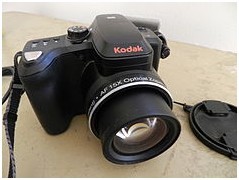
A Kodak Easyshare Z1015 IS Digital Camera
Many of Kodak's early compact digital cameras were designed and built by Chinon Industries, a Japanese camera manufacturer. In 2004 Kodak Japan acquired Chinon and many of its engineers and designers joined Kodak Japan.
The Kodak DCS series of digital single-lens reflex cameras and digital camera backs were released by Kodak in the 1990s and 2000s, and discontinued in 2005. They were based on existing 35mm film SLRs from Nikon and Canon and the range included the original Kodak DCS, the first commercially-available digital SLR.
In July 2006 Kodak announced that Flextronics would manufacture and help design its digital cameras.
Digital picture frames
Kodak first entered the digital picture frame market with the Kodak Smart Picture Frame in the fourth quarter of 2000. It was designed by Weave Innovations and licensed to Kodak with an exclusive relationship with Weave's StoryBox online photo network. Smart Frame owners connected to the network via an analog telephone connection built into the frame. The frame could hold 36 images internally and came with a six-month free subscription to the StoryBox network.
Kodak re-entered the digital photo frame market at CES in 2007 with the introduction of four new EasyShare-branded models that were available in sizes from 200 to 280 mm (8 to 11 inches), included multiple memory card slots, and some of which included wi-fi capability to connect with the Kodak Gallery—that gallery functionality has now been compromised due to gallery policy changes (see below).
Document imaging
Kodak provides document imaging solutions. Historically this industry began when George Eastman partnered with banks to image checks in the 1920s. Through the development of microfilm technology, Eastman Kodak was able to provide business and government with a solution for long term document storage. Document imaging was one of the first imaging solutions to move to "digital imaging" technology. Kodak manufactured the first digital document scanners for high speed document imaging. Today Kodak has a full line of document scanners providing imaging solutions for banking, finance, insurance, healthcare and other vertical industries. Kodak also provides associated document capture software and business process services. Eastman Kodak acquired the Bowe Bell & Howell scanner division in September 2009.
Flexo printing
Kodak designs and manufactures products for flexography printing. Its Flexcel line of flexo printing systems allow label printers to produce their own digital plates for customized flexo printing and flexible printed packaging.
Image sensors
As part of its move toward higher end products, Kodak announced on September 15, 2006 that the new Leica M8 camera incorporates Kodak's KAF-10500 image sensor. This was the second recent partnership between Kodak and the German optical manufacturer.
Kodak Gallery
In June 2001, Kodak purchased the photo-developing website Ofoto, later renamed Kodak Gallery. The website enables users to upload their photos into albums, publish them into prints, and create mousepads, calendars, etc. On March 1, 2012, Kodak announced that it will sell the Kodak Gallery to Shutterfly for $23.8 million.
Motion picture and TV production
The Kodak company holds a vital role in the invention and development of the motion picture industry. Many cinema and TV productions are shot on Kodak film stocks.
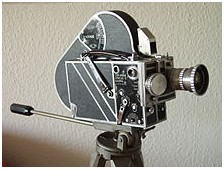
Ciné-Kodak Special II 16mm movie camera
The company helped set the standard of 35 mm film, and introduced the 16 mm film format for home movie use and lower budget film productions. The home market-oriented 8 mm and Super 8 formats were also developed by Kodak. Kodak also entered the professional television production video tape market, briefly in the mid-1980s, under the product portfolio name of Eastman Professional Video Tape Products. In 1990, Kodak launched a Worldwide Student Program working with university faculty throughout the world to help nurture the future generation of film-makers. Kodak formed Educational Advisory Councils in the US, Europe and Asia made up of Deans and Chairs of some of the most prestigious film schools throughout the world to help guide the development of their program.
Kodak owns the visual effects film post-production facilities Cinesite in Los Angeles and London and also LaserPacific in Los Angeles. Kodak also owns Pro-Tek Media Preservation Services in Burbank, California. Pro-Tek is the world's premier film storage company.
Photographic film and paper
Kodak continues to produce specialty films and film for newer and more popular consumer formats, while it has also discontinued the manufacture of film in older and less popular formats.
Kodak is a leading producer of silver halide (AgX) paper used for printing from film and digital images. Minilabs located in retail stores and larger central photo lab operations (CLOs) use silver halide paper for photo printing. In 2005 Kodak announced it would stop producing black-and-white photo paper.
Photo kiosks
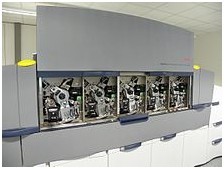
A Kodak NexPress 2500 digital printing press.
Kodak is a manufacturer of self-service photo kiosks that produce "prints in seconds" from multiple sources including digital input, scanned prints, Facebook, the Kodak Gallery and orders placed on-line using thermosublimation printers. The company has placed over 100,000 Picture Kiosks in retail locations worldwide. Employing similar technology, Kodak also offers larger printing systems with additional capabilities including duplex greeting cards, large format poster printers, photobooks and calendars under the brand name "APEX".
Technical support and on-site service
Aside from technical phone support for their products, Kodak offers onsite service for other devices such as document scanners, data storage systems (optical, tape, and disk), printers, inkjet printing presses, microfilm/microfiche equipment, photograph kiosks, and photocopiers, for which they dispatch technicians who make repairs in the field.
Other
Kodak markets Picture CDs and other photo products such as calendars, photo books and photo enlargements through retail partners such as CVS, Walmart and Target and through its Kodak Gallery online service, formerly known as Ofoto.
Former
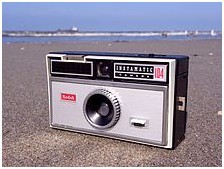
A Kodak Instamatic 104
Still film cameras
On January 13, 2004, Kodak announced it would stop marketing traditional still film cameras (excluding disposable cameras) in the United States, Canada and Western Europe, but would continue to sell film cameras in India, Latin America, Eastern Europe and China. By the end of 2005, Kodak ceased manufacturing cameras that used the Advanced Photo System. Kodak licensed the manufacture of Kodak branded cameras to Vivitar in 2005 and 2006. After 2007 Kodak did not license the manufacture of any film camera with the Kodak name.
Instant cameras
After losing a patent battle with Polaroid Corporation, Kodak left the instant camera business on January 9, 1986. The Kodak instant camera included models known as the Kodamatic and the Colorburst.
Polaroid was awarded damages in the patent trial in the amount of $909,457,567.00, a record at the time. (Polaroid Corp. v. Eastman Kodak Co., U.S. District Court District of Massachusetts, decided October 12, 1990, case no. 76-1634-MA. Published in the U.S. Patent Quarterly as 16 USPQ2d 1481). See also the following cases: Polaroid Corp. v. Eastman Kodak Co., 641 F.Supp. 828 [228 USPQ 305] (D. Mass. 1985), stay denied, 833 F.2d 930 [5 USPQ2d 1080] (Fed. Cir.), aff'd, 789 F.2d 1556 [229 USPQ 561] (Fed. Cir.), cert. denied, 479 U.S. 850 (1986).
Kodak was the exclusive supplier of negatives for Polaroid cameras from 1963 until 1969, when Polaroid chose to manufacture its own instant film.
Operations
Subsidiaries
• Kodak Limited (UK)
o the Company's sales and marketing headquarters are located at Hemel Hempstead in Hertfordshire
o manufacturing facilities are sited at Harrow in north-west London, Kirkby near Liverpool, and Annesley in Nottinghamshire
• FPC, Inc.
o FPC, US/Canada
o FPC Italy
Kodak Research Laboratories
The Kodak Research Laboratories were founded in 1912 with Kenneth Mees as the first director. Principal components of the Kodak Research Laboratories were the Photographic Research Laboratories and then the Imaging Research Laboratories. Additional organizations included the Corporate Research Laboratories. Over nearly a century, scientists at these laboratories produced thousands of patents and scientific publications.
Notable people
Presidents and CEOs
| Name | Title | Tenure |
| Henry A. Strong | President | 1884 – July 26, 1919 |
| George Eastman | President | 1921 – April 7, 1925 |
| William G. Stuber | President | 1925–1934 |
| Frank W. Lovejoy | President | 1934–1941 |
| Thomas J. Hargrave | President | 1941–1952 |
| Albert K. Chapman | President | 1952–1960 |
| William S. Vaughn | President and CEO | 1960 – December 31, 1968 |
| Louis K. Eilers | President and CEO | January 1, 1969 – May 17, 1972 |
| Walter A. Fallon | President and CEO | May 18, 1972 – 1983 |
| Colby H. Chandler | CEO | May 1983 – June 1990 |
| Kay R. Whitmore | CEO | June 1990 – October 27, 1993 |
| George M. C. Fisher | CEO | October 28, 1993 – December 31, 1999 |
| Daniel A. Carp | CEO | January 1, 2000 – May 31, 2005 |
| Antonio M. Pérez | Chairman and CEO | June 1, 2005 – present |
Scientists
• Bryce Bayer, color scientist (1929-2012).
• Harry Coover, polymer chemist (1917–2011)
• F. J. Duarte, laser physicist and author (left in 2006)
• Loyd A. Jones, camouflage physicist (1884–1954)
• Maurice Loyal Huggins, polymer scientist (1897–1981)
• Rudolf Kingslake, optical designer (1903–2003)
• David MacAdam, color scientist (1910–1998)
• Kenneth Mees, film scientist and founder of the research laboratories (1882–1960)
• Perley G. Nutting, physicist and founder of OSA (1873–1949)
• Steven Van Slyke, OLED scientist (left in 2010)
• Warren J. Smith, optical engineer (1922–2008)
• Ching W. Tang, OLED scientist (left in 2006)
Archive donation
In 2005, Kodak Canada donated its entire historic company archives to Ryerson University in Toronto. The Ryerson University Library also acquired an extensive collection of materials on the history of photography from the private collection of Nicholas M. & Marilyn A. Graver of Rochester, New York. The Kodak Archives, begun in 1909, contain the company's Camera Collection, historic photos, files, trade circulars, Kodak magazines, price lists, daily record books, equipment, and other ephemera. It includes the contents of the Kodak Heritage Collection Museum, a museum established in 1999 for Kodak Canada's centennial that Kodak closed in 2005 along with the company's entire 'Kodak Heights' manufacturing campus in Mount Dennis, Toronto.
Environmental record
Kodak has been widely criticized by environmentalists and researchers as one of the worst polluters in the United States. According to scorecard.org, a web site that collects information on corporate pollution, Kodak is the worst polluter in New York State, having released 4,433,749 pounds (2,011,115 kg) of chemicals into the environment.
The Political Economy Research Institute at the University of Massachusetts Amherst, which compiled the Toxic 100, ranked Kodak the seventh largest polluter in the United States in 2002. In 2004, the Citizens' Environmental Coalition's (CEC) of New York awarded Kodak one of its "Dirty Dozen" awards to highlight its consistently high rates of pollution.
Kodak details its annual progress in global sustainability, as well as health, safety, and environment, in its global sustainability report.
Controversies
Better Business Bureau
On March 26, 2007, the Council of Better Business Bureaus (CBBB) announced that Eastman Kodak was resigning its national membership in the wake of expulsion proceedings initiated by the CBBB Board of Directors. In 2006, Kodak notified the BBB of Upstate New York that it would no longer accept or respond to consumer complaints submitted by them. In prior years, Kodak responded by offering consumers an adjustment or an explanation of the company’s position. The BBB file contains consumer complaints of problems with repairs of Kodak digital cameras, as well as difficulty communicating with Kodak customer service. Among other complaints, consumers say that their cameras broke and they were charged for repairs when the failure was not the result of any damage or abuse. Some say their cameras failed again after being repaired.
Kodak said its customer service and customer privacy teams concluded that 99 percent of all complaints forwarded by the BBB already were handled directly with the customer. Brian O’Connor, Kodak chief privacy officer, said the company was surprised by the news release distributed by the Better Business Bureau:
It is inaccurate in the facts presented as well as those the BBB chose to omit. Ironically, we ultimately decided to resign our membership because we were extremely unhappy with the customer service we received from the local office of the BBB. After years of unproductive discussions with the local office regarding their Web site postings about Kodak, which in our view were consistently inaccurate, we came to the conclusion that their process added no value to our own. Our commitment to our customers is unwavering. That will not change. What has changed is that, for us, the BBB’s customer complaint process has become redundant, given the multiple and immediate ways that customers have to address their concerns directly with Kodak.
— Kodak
Patent litigation
In 2010, Apple filed a patent-infringement claim against Kodak. On May 12, 2011, Judge Robert Rogers rejected Apple's claims that two of its digital photography patents were being violated by Kodak.
On July 1, 2011, the U.S. International Trade Commission partially reversed a January decision by an administrative law judge stating that neither Apple nor Research in Motion had infringed upon Kodak's patents. The ITC remanded the matter for further proceedings before the ALJ."Notice of Commission Determination."
Class action lawsuit
On September 22, 2011, a class action complaint was filed in the Superior Court of California, County of Orange, Daniela Apostol v. Eastman Kodak Company.
The complaint alleges that Kodak engaged in wrongful business practices by not informing consumers that its All-In-One inkjet printers are designed in such a way, that both black and color inkjet cartridges are always used during printing, regardless of printer settings.
The complaint also alleges that the printer design necessitates that both black and color cartridges be installed for the printer to operate, even when the intent is to print a black and white document, and that the combination of these design aspects results in forced purchases of color inkjet cartridges.
Share this page



















